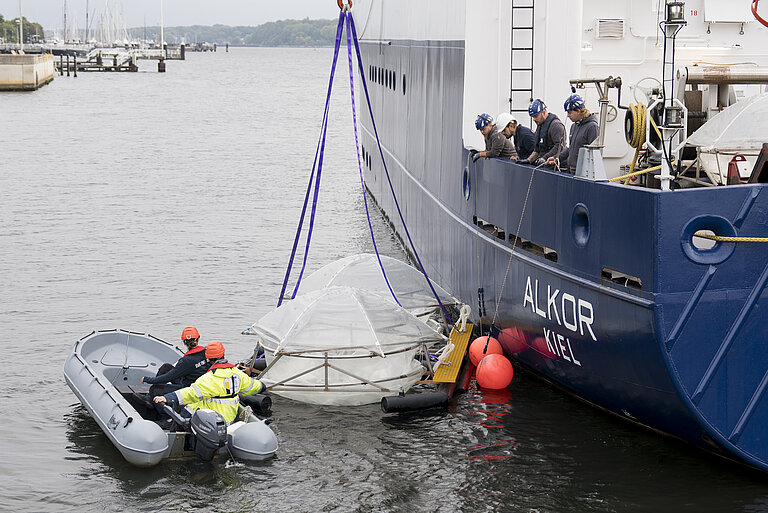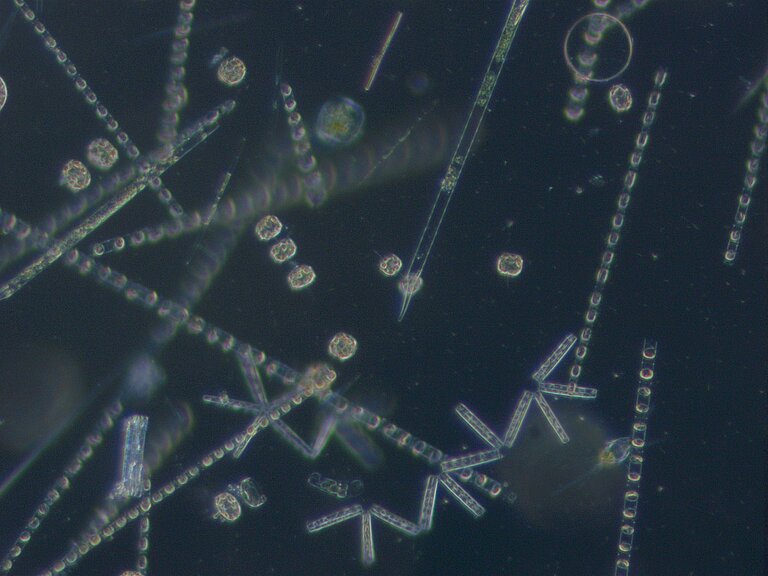GEOMAR Helmholtz Centre for Ocean Research Kiel
Wischhofstr. 1-3
24148 Kiel
GERMANY
Media requests: media(at)geomar.de
Events and all other topics: outreach(at)geomar.de
As the drastic reduction of greenhouse gas emissions alone will not be sufficient to achieve national and international climate protection targets, researchers are intensively searching for ways to actively remove carbon dioxide (CO2) from the atmosphere. One approach is to increase the alkalinity of the ocean so that it can absorb more CO2.
How does the alkalinity increase work?
The alkalinity increase in the ocean mimics the natural process of rock weathering, which has helped to stabilise the Earth's climate over the past billions of years. Now, however, the carbon dioxide input caused by humans is about a hundred times too fast to be balanced by natural weathering. The direct addition of alkaline minerals to the sea has the same effect: the pH value rises and this reduces the CO2 concentration in the surface ocean. As the ocean and atmosphere endeavour to balance each other out, more CO2 is transported from the atmosphere into the ocean.
The autumn experiment
In order to investigate the effects of an increase in alkalinity on marine ecology, twelve self-contained experimental enclosures, known as mesocosms, were once again deployed at the pier in front of the Kiel Aquarium on Wednesday, 25 September 2024 and filled the following day. They each isolate 8,000 litres of fjord water along with the plant and animal plankton it contains. The environmental conditions in the mesocosms are therefore the same as in the sea - but there is no water exchange. For four weeks after the addition of minerals in different concentrations, the reaction of the ecosystem to the increase in alkalinity is closely monitored. This is the last of three mesocosm deployments this year each lasting several weeks.
Initial results and new findings
The two experiments in spring and summer have already yielded initial results. For example, concerns that mineral impurities could release potentially toxic trace elements into the sea have proven unfounded.
A clear effect on microalgae was observed: With increasing alkalinity, a decline in the growth of diatoms was observed in spring and summer. One possible explanation is that mineral particles become entangled in the diatom chains, acting as ballast and causing them to sink. A chemical effect in which the high pH value in the vicinity of the dissolving minerals damages the algae's silica armour could also play a role. These hypotheses are now being investigated further in the autumn experiment.
A third finding concerns the precipitation of calcium carbonate: In previous laboratory studies, it was observed that calcium carbonate (CaCO3) precipitates when alkalinity is raised too high, which in turn reduces alkalinity and leads to inefficiencies. This process was sometimes so rapid and intense that in the end more alkalinity was lost than was added by minerals. Although this effect also occurred in the mesocosm experiments, it did not lead to excessive carbonate precipitation. This is probably due to the fact that the calcium carbonate particles in the mesocosms sank out relatively quickly after their formation. This removed them from the water column before they could drive the precipitation any further. The experiment therefore shows that under real conditions in the sea, this ‘runaway’ effect is less likely than previously thought.
Outlook
‘Not all the data has been analysed yet, but these three findings are already highlights that could not have been obtained without our experimental setup with the mesocosms,’ explains Dr Ulf Riebesell, Professor of Biological Oceanography at GEOMAR Helmholtz Centre for Ocean Research Kiel. The results have already been able to revise some presumptions that were based on less realistic experimental set-ups.
Background: Ocean Alk-Align
Ocean Alk-Align is an international research project investigating the efficiency and durability, environmental safety and requirements for Monitoring, Reporting, and Verification (MRV) of marine alkalinity enhancement. The aim is to create a sound knowledge base to assess the potential application of this technology. Ocean Alk-Align is coordinated by the University of Dalhousie, Canada. GEOMAR, the University of Hamburg and the Universities of Southern Cross and Tasmania, Australia, are also involved. The project is funded by the US ‘Carbon to Sea’ initiative.

Experimental setup at the pier: In the coming weeks, the mesocosms will again be used to investigate how an increase in alkalinity affects marine life. Photo: Ulf Riebesell, GEOMAR

Preparations for the autumn experiment: The mesocosms are lifted from the research vessel ALKOR. Photo: Sarah Uphoff, GEOMAR

A diatom community under the microscope: The Ocean Alk-Align project is investigating how an increase in alkalinity affects these microalgae. Photo: Annegret Stuhr, GEOMAR

